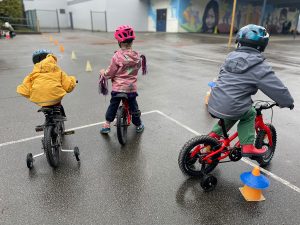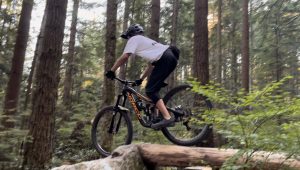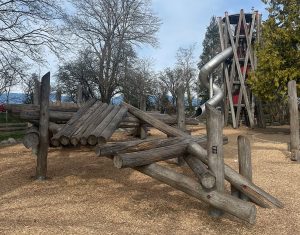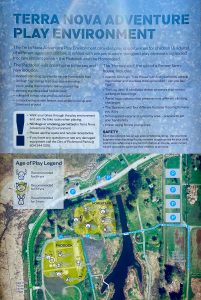
Jeffrey Felix
Jeffrey Felix has worked as a professional bike instructor for over seven years and has gained experience educating youth in various capacities. He is currently working towards his Bachelor of Education, and has spent over 100 hours volunteering in B.C. classrooms. Jeffrey finds joy in teaching and wishes to become an elementary school teacher.
On a brisk spring day my parents told me the news. I was seven years old and the words came as a shock. Simultaneously, I was filled with excitement and fear. As these emotions swirled around in my mind, I no longer felt reassured in my own capabilities. Although I knew this day would come, it nevertheless felt far too soon. My support structure was being stripped away and I was going to be on my own. The thought of complete independence frightened me. As a wave of nervousness rushed through my body, I realized, my training wheels were coming off.
I currently work as the British Columbia Regional Operations Coordinator for a multinational bike camp company. I enjoy taking part within the learning and teaching process and my goal is to eventually become an elementary school teacher. Throughout my current position at the bike camp and volunteer work within a kindergarten classroom, I am working to find my teaching voice and develop my experience with youth, both within and outside of a classroom setting. The bike camp I work for caters to youth, from ages two-and-a-half to twelve, and focuses on developing a wide range of biking skills. With over forty different camp locations in British Columbia, various different levels are available, ranging from pre-school levels, training wheel removal levels, road safety/road riding levels, and mountain biking levels. Throughout my seven years at the bike camp, I have spent an extensive amount of time teaching each level and working with youth of all ages. Though I have worked in various positions with the company, over the past seven years I have continuously made it a top priority to remain involved in the teaching and learning process. As I continue to learn new bike skills, and develop my riding capabilities through activities such as mountain biking, I find joy in passing on the knowledge that I have accumulated throughout my many years riding on two wheels.

A group of young riders hone their skills on a new obstacle course. The group is in the process of removing their training wheels on a rainy day in Burnaby, BC.
Despite attempting to operate the safest camp possible, it is important to understand that an activity such as bike riding is inextricably linked to an element of risk at every offered level. As an educator it is up to me to help mitigate risks as much as possible. However, in spite of being able to diminish many large and preventable risks, small falls resulting in scrapes and bruises are, by nature, part of the activity and therefore impossible to eliminate completely. Within the camp environment, the majority of campers knowingly and actively take part in biking activities despite understanding that there is an element of risk involved with riding bikes. I actively engage in similar risk when mountain biking and attempting new and unfamiliar trail features. After witnessing both kids and adults fall countless times and acquire all sorts of scrapes and bruises, a realization struck me. These small falls are all a part of the learning process. I find these risks not to be solely a by-product of an unfamiliar activity, but to be a vital aspect to learning as well as biking as a whole. The small risks we take ultimately enhance our learning and our perception regarding what is and what isn’t possible in relation to our own personal limitations. Having said this, it is without doubt the educator’s role to control the setting in which these small falls take place. Children should not be expected to innately know their own limitations. By controlling the setting in which risk takes place, educators can create learning moments when these accidental falls do happen, all the while attempting to also expose children to a greater sense of independence. This, ideally, will also result in youth understanding risk in a more comprehensive way all the while developing personal strategies to mitigate their own risk. By realizing risks and personal limitations when being exposed to controlled risks, children are offered the opportunity to learn in an entirely different but meaningful way. This element of learning from risky behaviour is not only applicable to sports and activities such as biking, but it is also relevant to the play and learning that occurs at daily on school playgrounds.
When understanding the necessity of risk within both youth and adult learning, the sport of mountain biking offers some thought provoking ideas. Mountain biking is an activity almost founded on the presence of at least some element of risk. Lukas Behringer speaks to not only the existence of this risk within the sport, but also how the mountain biking community has reacted to the presence of risk in relation to its exposure to riders who are new and learning the sport. Behringer is a Professional Mountain Biking Instructor Association (PMBIA) certified educator and has worked as a trail and mountain bike instructor at a multitude of bike camps, including Whistler Bike Park. In addition to these riding and instructing credentials, Behringer also has experience with trail building. Through the implementation, testing, and development of risky features within the trail building and trail riding Behringer is both qualified and well practiced in situations of risk. Throughout his extensive amount of time spent in the mountain bike community, Behringer has both successfully and unsuccessfully ridden a wide variety of difficult features and terrain. It is both his successful experiences combined with his understanding of risk and his encounters with serious injury that make Behringer such a knowledgeable and down-to-earth educator.

Lukas Behringer successfully clears a gap jump on the trail Home Brew in Squamish, BC.
Within an interview, discussing the presence of risk within mountain biking, Behringer offers a historical analysis of the sport. He speaks of the origins and development of freeride mountain biking on the North Shore of Vancouver throughout the 1990’s and how the sport has evolved into its current form. Behringer reveals, “The North Shore of Vancouver is the birthplace of freeride mountain biking. It’s really where the first three dudes got paid to not be in an official competition or race… It was raw, it was loose, there were no regulations, [and] the features were illegal. Some of them got torn down some of them didn’t.” This unsanctioned era of freeride mountain biking that Behringer references was not without its controversies. In its original form, the sport faced major challenges due to its unauthorized use of local forests and trails. Within a CBC News’ article on the freeride mountain biking historical documentary “The Moment,” early challenges to the sport are outlined, stating, “Freeriding wasn’t always as accepted and celebrated as it is now. There was a lot of tension in the early years of the sport between riders and landowners… Some landowners would so far as to sabotage bike trails” (CBC News). Despite these challenges, this completely unendorsed version of the sport meant that there was no limit to the risk freeride features could present to riders. There was no governing body, such as the North Shore Mountain Biking Association (NSMBA), to approve or restrict the building of dangerous features as it does today. The NSMBA, however, would be established soon after “in the winter of 1997 in response to trail sabotage”. Since 1997, the NSMBA has acted as a legitimate and unified organization comprised of the North Vancouver freeride mountain biking community. Until the foundation of this governing body, the use and building of trail features would remain largely unregulated.
In response to the existence and survival of these pre-NSMBA features within the North Shore of Vancouver, Behringer articulates, “That’s really how a lot of it has stayed for a long time until about five years ago… I think a very big part of this controversy is the fact that the mountain biking community, because of its birthplace being on the North Shore, is now also the mecca of the world.” With the staggering amount of growth that freeride mountain biking has seen within the last 30 years, new and developing riders of all ages are being exposed to the biggest and most dangerous features mountain biking has to offer. This is a very real and current problem. Riders who may not be capable of riding these extremely risky features can face serious injury if they are exposed to such risk at the wrong time within their riding progression. Although risk is a necessary aspect of the sport, risk must be properly managed by both educators and governing bodies such as the NSMBA. Because of this, the North Shore of Vancouver has seen some of their beloved risky features being altered to improve the overall safety of a trail, or removed entirely. This has sparked a large amount of controversy within the mountain biking community. The dilemma of catering towards beginner riders or retaining more dangerous historical features is a problem that has been widely discussed.
To Behringer, the decision to alter risky features in the name of safety and learning is, in fact, the right decision. The North Shore of Vancouver holds some of the most easily accessible trails within British Columbia as a whole and accordingly an ease of difficulty level should be reflected as a result of this ease of access. According to Behringer, a paradox presents itself when the most easily accessible trails are the trails that pose the most risk to people who are new to the sport. In reference to this, Behringer claims its “kind of counter-intuitive. People wanting to get into mountain biking, being complete beginners, and then going to the most dangerous, most gnarly, most technically advanced, and least safe trails in the world. I think that is a natural contradiction.” As difficult as it is to say goodbye to some of what is commonly described as “North Shore gnar,” it is the correct decision in order to foster better learning with less chance of serious injury.
To be clear, Behringer is not against risk within mountain biking, rather, he promotes it in what he deems to be the right circumstances. When discussing the benefits of falling Behringer brings up the necessity to fall at least somewhat, in hopes to discover ones own limitations. Through falling within the optimal settings, one can learn so much about personal capabilities and the limitations of biking in general. If a rider experiences a fall in a setting that is too advanced, it does not facilitate positive learning as the situation can result in serious injury or worse. To illustrate this Behringer states, “I think ‘have to fall’ sounds really dangerous when it comes to liability and parents very quickly… When I say you ‘need to fall’ to learn your own limitations, I don’t mean you want to fall off a ten foot drop.” Here Behringer identifies variability regarding risk. New riders, especially under the supervision of an experienced mountain bike instructor should not be put in a position where their safety is outright jeopardized, however, risk can still be considered a necessary aspect to the activity. Here it is first up to the instructor to identify the needs of the developing riders. Through practice and development on less risky features, riders can perfect basic skills before attempting more advanced features. Behringer continues stating, “I definitely think that as a rider, you should work your way up from something that’s so safe that if you did have a full scale, worst-case scenario type of crash you’re basically going to be fine.” This idea of being able to personally identify risk and react accordingly is a core skill in mountain biking. It is a learned skill that must be taught and it is a skill that only develops with practice of being exposed to risk.
When discussing the correlation between mountain biking and risk, Behringer firmly proclaims, “Risk is integral to mountain biking as a sport. That is what it is… Optimization and reduction do not eliminate random chance.” This can be a difficult component of the sport for many to unpack, however it is crucial to understand when addressing the topic of rider safety and risk. What Behringer refers to is the possible chance that the worst fall could happen at any time. The nature of bike riding or any risky activity is that a variety of dangerous things could happen at any given moment regardless of personal awareness or skill level. At any point in time, a devastating accident could occur and affect any and all participants. What Behringer alludes to, is that the fear of the worst possible outcome is ultimately uncontrollable. It is useful to weigh the possibility these risks, however, the existence of risks do not necessarily warrant the removal of risk as a whole within these activities.

Jeffrey Felix approaches a steep rock roll, following an elevated skinny on the trail Lower Crippler, located on Mount Fromme, BC.
The willing participation of children within risky play can offer some insight into this topic, and seem to point to risky play serving a real function within the growth and development of youth. Ellen Beate Hansen Sandseter et al. elaborates on the eager participation of youth within risky play activities. Within her 2021 article “The Prevalence of Risky Play in Young Children’s Indoor and Outdoor Free Play”, Sandseter details, “Children engaged in risky play to a varying degree. Four of the 86 children did not engage in risky play” (Sandseter et al.). Within her findings, Sandseter et al. puts forth that risky play is not rare amongst learning children. In fact 95.35% of children studied participated in risky play. Moreover, Sandseter et al. proposes that participation within risk is equally valuable regardless of gender. Sandseter et al. states “There are no significant differences between boys and girls in total engagement in risky play” (Sandseter et al.). This points to equal engagement and benefit across all of the children studied. Adding to the equal participation in risky play of boys and girls, Junjie Liu and Astra Birkeland put within their 2022 article on risky play, titled “Perceptions of Risky Play Among Kindergarten Teachers in Norway and China” another interesting aspect of risk. Liu and Birkeland notice cross-cultural similarities through analyzing children in both Norway and China.
Within their article, Liu and Birkeland support the reasoning that children from various backgrounds engage in risky play despite different cultural understandings of risky play. Furthermore, they suggest “the overall positive health effects of increased risky outdoor play provide greater benefit than the health effects associated with avoiding such play” (Liu & Birkeland). Here Liu and Birkeland acknowledge the very possible risk of injury when taking part in risky outdoor play, however, the two also recognize greater negative health effects if risky play does not take place. Adding to this, Liu and Birkeland offer a somewhat grim outlook on recent risk reduction, stating, “there has been growing concern that, as many western societies become increasingly risk-averse, children’s freedom in outdoor play will be restricted” (2022). Encapsulated in this statement, is the scary possibility that educational risk can be taken away from youth when attempting to mitigate risk. Despite this possibility, actions are being taken by various municipalities in efforts to retain risk in its most educational form.
Elementary school teacher of twelve years, Danielle Tortolano, speaks to the topic of risk in a rather refreshing light. Tortolano takes an extremely empathetic approach to youth partaking in risky play exclaiming, “When we are curious as kids we don’t care what people think. We just want to explore and learn how things work, and the more restraints you put on that and the more scheduling you do, the more you take away from what you could be or what you could have done.” In her position as a kindergarten teacher, Tortolano is careful not to immediately shut down all forms of risky play. Although dangerous actions are not permitted, the outdoor space is treated as a place of risky play and learning. This is a setting where children first learn to run, jump and physically play without constant adult supervision. Although school recess monitors do supervise at recess and lunch hour, the few supervisors have many children to monitor simultaneously. Because of this, recess often operates as a defining era comprised of personal engagement in risky play within a child’s life. The existence of independent play amongst youth is extremely important and can sometimes be overlooked. The work of Helen Little, in her article “‘It’s about Taking the Risk’: Exploring Toddlers’ Risky Play in a Redesigned Outdoor Space,” seems to support Tortolano’s opinions on fighting the urge to intervene within child play. When studying with risky play amongst pre-schoolers, Little states, “By stepping back and watching children, giving them the time and space to make their own decisions, practitioners saw that children were capable not only in terms of their motor competence but also in adhering to the ‘rules’ that had been developed, and managing their own safety.
Because of recent research surrounding the positive aspects of risk, risky play structures are becoming more and more common. This can be seen within the City of Richmond through their implementation of Terra Nova Adventure Play Environment in 2016. This, free to use, state of the art risky playground has much to offer and is not only for children but people of all ages. The playground is situated on the northwest corner of Richmond, BC and offers breathtaking natural scenery overlooking the Sturgeon Banks Natural Area. Despite boasting some pretty risky features, such as two 35m zip lines and swings reaching 3m high, the Terra Nova Adventure Play Environment is not without its safety rules. The Terra Nova Adventure Play Area is equipped with an “Age of Play Legend” which reveals suggested an “age appropriateness rating” for each section of the playground. Through this legend, dangerous risk is mitigated in hope to better make room for educational risk.

With it’s risky play features, Richmond BC’s Terra Nova Adventure Play Environment, acts as a area where children (and Adults) can learnthrough using personal judgement while playing on unfamiliar terrain and equipment.
Despite fears regarding introducing risk within educational settings, it seems risk is a necessary aspect to learning as a whole. As an educator, it is always difficult to justify exposing youth to risk and unfamiliar situations. Regardless of this perceived difficulty, risk is proven to be a valuable learning tool. It is up to educators to mitigate risk, however, it is vital that they do not over-mitigate situations of risk. Because common rover-mitigation of risk, youth being exposed to controlled risk is now more important than ever. This controlled risk heightens decision-making skills as well as teaches children about individual limitations and how to work within those limitations.

The Terra Nova Adventure Play Environment “Age of Play Legend” serves as a guideline for park users of all ages. The use of animal pictographs, correlating to age, ensures that even users who don’t fully know how to read can understand suggested play areas with only a little help.
Seventeen years after learning to ride with no training wheels I find myself on an unfamiliar mountain bike trail on the North Shore of Vancouver. I am riding on Mount Fromme. It is the area that gave birth to sport of freeride mountain biking well before I had even begun to ride. As I approach an elevated skinny that is approximately six inches wide, I feel a recognizable wave of nervousness come over me. Looking ahead I notice that this feature has a multitude of risky factors including a steep roll immediately following the skinny. In spite of this wave of nervousness, I continue pedaling over and across the skinny log. As I weigh the risk in my head, I carry my speed over the slightly uphill feature and transition into the steep downhill roll. I keep my weight a little farther back, as I am cautious not to fly OTB (over the bars). As I accomplish the feature for the first time, I immediately feel both relief and joy. I am proud of myself for rising up to the challenge. I quickly gather my thoughts and focus on the next upcoming risky feature.
Bibliography
“Documentary Tells Origin Story of B.C. Mountain Biking.” CBC News, December 9, 2017. https://www.cbc.ca/news/canada/british-columbia/documentary-tells-origin-story-of-b-c-mountain-biking-1.4440236
Ferreras, Jesse. “Richmond Made A Playground Risky. Now Another Community Is Following Suit.” Huffpost, March 14, 2016. https://www.huffpost.com/archive/ca/entry/richmond-made-a-playground-risky-now-another-community-is-follo_n_9464388
“History.” NSMBA, https://nsmba.ca/history/. Accessed April 6, 2023.
Little, Helen. “ ‘It’s about Taking the Risk’: Exploring Toddlers’ Risky Play in a Redesigned Outdoor Space.” Education Sciences, vol. 12, no. 10, Oct. 2022, https://doi-org.ezproxy.capilanou.ca/10.3390/educsci12100677.
Liu, Junjie, and Asta Birkeland. “Percertions of Risky Play among Kindergarten Teachers in Norway and China.” International Journal of Early Childhood: Journal of OMEP: L’organisation Mondiale Pour l’Education Prescolair, Jan. 2022, pp. 1-22. http://doi-org.ezjproxy.capilanou.ca/10.1007/s13158-021-00313-8.
Sandseter, Ellen Beate Hansen, et al. “The Prevalence of Risky Play in Young Children’s Indoor and Outdoor Free Play.” Early Childhood Education Journal, vol. 49, no. 2, Mar. 2021, pp.303-312. https://doi-org.ezproxy.capilanou.c/10.1007/s10643-020-01074-0.
